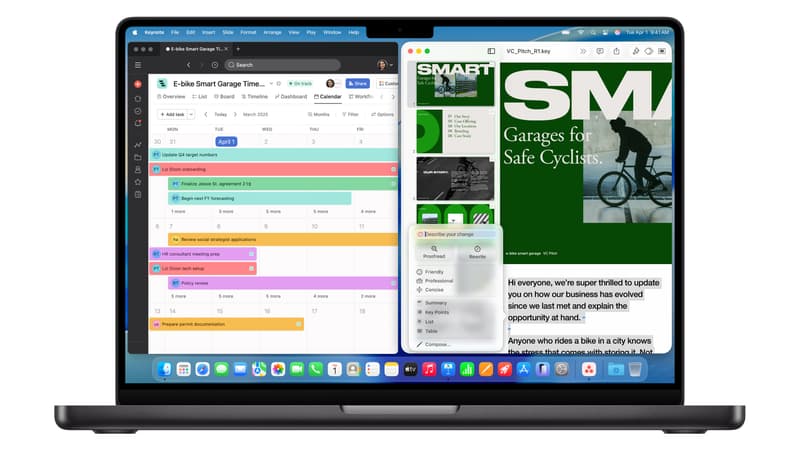They weren’t even rumors anymore. The US FCC had betrayed the secrecy, to the point that we were patiently waiting for the announcements. Here they are. Apple just suddenly introduced a new iPad Pro, a new Vision pro, and a new 14-inch Macbook Pro (only). Three products that have one thing in common: they work with the same SoC, the new M5, a Mac version of the A19 chips introduced in the iPhone Air, 17 and 17 Pro. Those who need more power and want to opt for the Pro and Max versions of the M chips will have to wait a little longer.
An ultraportable that has nothing left to prove
Descendants of the 13-inch Macbook Pro, which at the time were among the first to switch to Apple Silicon chips, the 14-inch Macbook Pro retain the design presented in October 2021. Offered in two finishes, Space Black and Silver, they are available in three 14-inch models, always with a Liquid Retina contrast.
An interesting point: Apple does not distinguish them by the integrated SoC and more precisely by the number of CPU or GPU cores, as may have been the case in the past. Here, all ultraportables benefit from ten CPU cores (central computing unit), ten cores (graphics computing and AI) and 16 neural engine (AI) cores.
The same thing, they all show the same number of Thunderbolt 4 ports, and not Thunderbolt 5 as on the higher-end models. There are three of these ports and in USB-C format. There’s also an HDMI port, an SDXC card reader, a MagSafe port, and a headphone/microphone jack. The keyboard is still a Magic Keyboard, which ended up making us forget the pleasure of use and the failure in durability of butterfly keyboards. In our opinion, it offers one of the best writing experiences on the market, which combines perfectly with the large Force Touch touchpad, very practical for window control actions in macOS.
There is obviously a Touch ID fingerprint reader at the top right of the keys. No Face ID, so not this time. But a 12 MP camera compatible with the Centered Frame function to ensure that you are always the center of attention during your video conferences.
Ultimately, the difference comes down to the amount of built-in memory and storage. Thus we find:
- A Macbook Pro M5 – 16 GB – 512 GB SSD storage at 1,799 euros
- A Macbook Pro M5 – 16 GB – 1 TB of SSD storage at 2,049 euros
- A Macbook Pro M5 – 24 GB – 1 TB of SSD storage at 2,299 euros
We appreciate that Apple has definitively turned the page on configurations with less than 16 GB of integrated RAM. Something very good at a time when uses that revolve around AI, which consume a lot of resources when run locally, are increasing. The maximum RAM supported is 32 GB for the M5.
Interestingly, the memory bandwidth has increased compared to the M4, going from 120 to 153 GB/s, which means that the unified memory should not be the cause of the slowdown, unless you saturate it, obviously. Hence the importance of choosing the amount of Ram well from the beginning, so as not to be limited later. The memory modules are, a priori, always soldered to the motherboard, around the SoC.
Maximum storage is set at 4TB on this “base” Pro model. Apple also notes that the SSD used for storage is up to twice as fast as previous generations. Very good news, not that this was a bug before, but read and write speeds can vary significantly depending on the amount of storage retained.
The M5 SoC at the center of attention and experience
The star of the day is, therefore, the M5, the new SoC for Mac. As in the A19 and A19 Pro, the GPU cores are enriched with neural accelerators to execute intelligent tasks more quickly. Apple thus indicates that the M5 would be 3.5 times faster than the M4 for the same AI task, and up to six times faster than the M1, launched in November 2020. Therefore, the execution of programs that use machine learning or an LLM should be much more efficient.
The graphics part is not far behind and should allow games to run more fluidly; the titles are still a bit weird. Apple claims up to 45% higher gaming graphics performance than the M4, with 1.6 times more frames per second in-game. For 3D rendering features, such as in Blender, Apple indicates that the M5 could be 1.6 times faster than the Macbook Pro M4 and 1.2 times more efficient for compiling programs in Xcode.
But if AI gets a lot of attention, and games too, the CPU part is not forgotten. It has four performance cores and six more low-power cores. The central processor cores are said to be 20% faster for the most demanding and optimized tasks.
In short, the 14-inch Macbook Pro M5 is the powerful and versatile ultraportable that Apple has accustomed us to for several years. The announced autonomy is 24 hours. And the performance is all the more impressive when you have to remember that Macbooks generally offer the same performance on battery or mains power.
The Macbook Pro M5 runs macOS Tahoe, which offers a revamped interface, with Liquid Glass, big improvements to Spotlight, a set of beefed-up Continuity features, and of course, a good number of Apple Intelligence features.
Source: BFM TV


